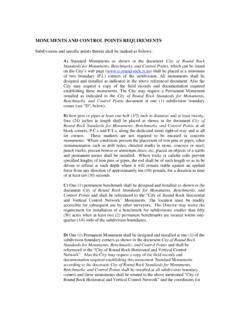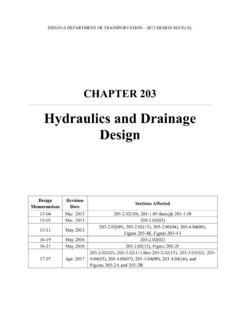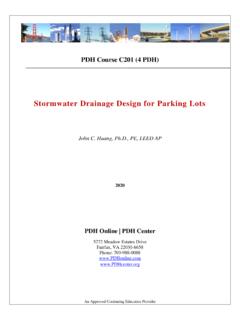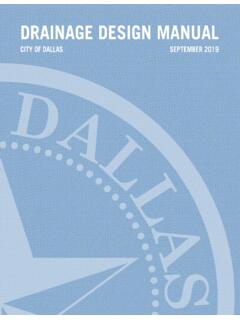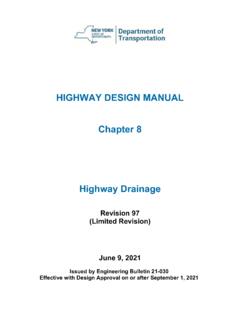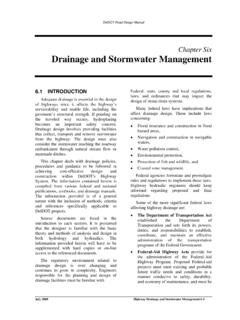Transcription of Drainage Culverts - Round Rock, Texas
1 7-1 SECTION 7 Culverts Table of Contents SECTION 7 Culverts Table of Contents .. 7-1 GENERAL .. 7-2 culvert HEADWALLS .. 7-2 General .. 7-2 Conditions at Entrance .. 7-3 Type of Headwall .. 7-3 Debris Fins.. 7-6 culvert DISCHARGE VELOCITIES .. 7-6 SELECTION OF culvert SIZE AND FLOW CLASSIFICATION .. 7-7 culvert Hydraulics .. 7-7 design Procedures .. 7-10 Instructions For Using Nomographs .. 7-12 Example 7-1 .. 7-14 HYDRAULIC CONSIDERATIONS IN BRIDGE design .. 7-15 General .. 7-15 Types Of Flow For Bridge design .. 7-16 Modeling Hydraulic Conditions .. 7-17 7-2 Drainage Criteria Manual SECTION 7 - Culverts SECTION 7 - Culverts GENERAL The function of a Drainage culvert is to pass the design storm flow without causing excessive backwater or overtopping of the structure and without creating excessive downstream velocities. The designer shall keep energy losses and discharge velocities within allowable limits when selecting a structure that will meet these requirements.
2 The design storm flow shall be determined by the hydrologic methods as set forth in Section 2 of this Manual. The system shall accommodate the runoff from a 100 year frequency storm meeting the limitations for overflows at bridges and Culverts set forth in Section and of this Manual. culvert HEADWALLS General The normal functions of properly designed headwalls and endwalls are to anchor the culvert in order to prevent movement due to hydraulic and soil pressures, to control erosion and scour resulting from excessive velocities and turbulence and to prevent adjacent soil from sloughing into the waterway opening. All headwalls shall be constructed of reinforced concrete and may be either straight-parallel, flared or warped. They may or may not require aprons, as determined by site conditions. Headwalls should be aligned with the direction of the receiving flow when discharging into a waterway.
3 Precast headwalls and endwalls may be used if all other criteria are satisfied; generally precast headwalls/endwalls are available for smaller Culverts eighteen (18) and twenty-four (24) inches diameter. 7-3 Conditions at Entrance The operating characteristics of a culvert may be completely changed by the shape or condition at the inlet or entrance. Therefore, design of Culverts must involve consideration of energy head losses that may occur at the entrance. Entrance head losses may be determined by the following equation: he = Ke(V22-V12)/2g (Eq. 7-1) where, he = Entrance head loss, feet V2 = Velocity of flow in culvert , ft/sec V1 = Velocity of flow approaching culvert , ft/sec Ke = Entrance loss coefficient as shown in Table 7-1 g = Acceleration due to gravity Type Of Headwall The common types of headwall entrances are shown in Figure 7-1 in Appendix B of this Manual, but are not limited to the designs shown there.
4 The following guidelines can be used in the selection of the type of headwall. Approach velocities are measured immediately upstream of the headwall under normal operating conditions. 7-4 Table 7-1 Values of culvert Entrance Loss Coefficients Type of Entrance Entrance Coefficient, Ke Pipe Headwall (no wingwalls) Grooved edge Rounded edge ( radius) Rounded edge ( radius) Square edge (cut concrete and CMP) Headwall with 45 Wingwalls Grooved edge Square edge Headwall with Parallel Wingwalls Spaced apart Grooved edge Square edge Beveled edge Projecting Entrance (no headwall or wingwalls) Grooved edge (RCP) Square edge (RCP) Sharp edge, thin walls (CMP) Sloping Entrance (no headwall or wingwalls) Mitered to conform to slope Flared-end section 7-5 Table 7-1 (Continued) Values of culvert Entrance Loss Coefficients Type of Entrance Entrance Coefficient, Ke Box, Reinforced Concrete Headwall Parallel to Embankment (no wingwalls)
5 Square edge on sides of opening Rounded on 3 edges to radius of 1/12 barrel dimension Wingwalls at 30 to 75 to barrel axis Square edged at crown Crown edge rounded to radius of 1/12 barrel dimension Wingwalls at 10 to 30 to barrel Square edged at crown Wingwalls parallel (extension of culvert walls) Square edged at crown RCP: Reinforced Concrete Pipe CMP: Corrugated Metal Pipe NOTE: The entrance loss coefficients are used to evaluate the culvert or sewer capacity operating under outlet control. Source: WRC Engineering, Inc. Boulder County Storm Drainage Criteria Manual, 1984. A. Parallel Headwall. 1. Approach velocities are low (below six (6) feet per second). 2. Backwater pools are permitted. B. Flared Headwall. 1. Approach velocities are between six (6) and ten (10) feet per second. 2. Ample right of way or easement is available.
6 The wings of flared walls should be located with respect to the direction of the approaching flow, not the culvert axis as in Figure 7-1 in Appendix B of this Manual. C. Warped Headwall. Approach velocities are between eight (8) and twenty (20) feet per second. Warped headwalls are effective with aprons to accelerate flow through the culvert . 7-6 Debris Fins. For conditions where more than one (1) box culvert is required, the upstream face of the structure shall incorporate debris deflector fins to prevent debris buildup. For multiple-pipe situations installations of debris fins may be used but are not required. The debris fin is an extension of the interior walls of a multiple-box culvert . The wall thickness shall be designed to satisfy structural requirements and reduce impact and turbulence to the flow. A debris fin is constructed to the height of the culvert . A fin length of one and five tenths ( ) times the height of the box culvert is required.
7 Since the debris fins are subject to the same erosive forces as bridge piers, care must be taken in the design of the footing. A toewall at the upstream end of the debris fin and the apron is recommended. Figure 7-2 in Appendix B of this Manual depicts the conceptual design for debris deflector fins. It should be noted that alternate types of wingwalls can be used other than the parallel shown in Figure 7-2 in Appendix B of this Manual. culvert DISCHARGE VELOCITIES High discharge velocities from Culverts can cause eddies or other turbulence which could damage unprotected downstream properties and roadway embankments. To prevent damage from scour and erosion in these conditions, culvert outlet protection is needed. This outlet protection is based on the discharge velocity. Velocity Outlet Protection Below six (6) ft/sec Riprap protection. (Four (4) inch minimum thickness) or alternate approved material. Above six (6) ft/sec Structurally reinforced apron, six (6) inch minimum thickness with toe wall.
8 The minimum apron length which provides transition from a culvert outlet to an open channel shall be calculated from the following equation: L = VD (Eq. 7-2) where, L = Apron length, feet V = culvert discharge velocity, ft/sec D = height of box culvert or diameter of pipe culvert , feet SELECTION OF culvert SIZE AND FLOW CLASSIFICATION Laboratory tests and field observations show that there are two (2) major types of culvert flow: (1) flow with inlet control; and (2) flow with outlet control. Under inlet control, the cross-sectional area of the barrel, the inlet configuration or geometry and the amount of headwater are the factors affecting capacity. Outlet control involves the additional consideration of the tailwater in the outlet channel and the slope, roughness and length of barrel. Under inlet control conditions, the slope of the culvert is steep 7-7 enough so that the culvert does not flow full and the tailwater does not affect the flow.
9 culvert Hydraulics A. Inlet Control Condition. Inlet control for Culverts may occur in two (2) ways. 1. Unsubmerged: The headwater is not sufficient to submerge the top of the culvert opening and the culvert inlet slope is supercritical. The culvert inlet acts like a weir (Condition A, Figure 7-3 in Appendix B of this Manual). 2. Submerged: The headwater submerges the top of the culvert but the pipe does not flow full. The culvert inlet acts like an orifice (Condition B, Figure 7-3 in Appendix B of this Manual). The discharge capacity for several culvert materials, shapes, and inlet configurations under inlet control conditions are presented in Figures 7-5 to 7-10 in Appendix B of this Manual. These nomographs were developed empirically by the Bureau of Public Roads, the Federal Highway Administration and various pipe manufacturers. The nomographs are recommended for use in all inlet-control culvert calculations.
10 B. Outlet Control Condition. There are three (3) types of outlet control culvert flow conditions: 1. The headwater submerges the culvert opening, and the culvert outlet is submerged by the tailwater. The culvert will flow full (Condition A, Figure 7-3 in Appendix B of this Manual). 2. The headwater submerges the culvert opening, the culvert outlet is not submerged by the tailwater (Condition B or C, Figure 7-3 in Appendix B of this Manual). 3. The headwater is insufficient to submerge the top of the culvert opening. The culvert slope is subcritical and the tailwater depth is lower than critical depth for the culvert (Condition D, Figure 7-3 in Appendix B of this Manual). The capacity of a culvert for outlet control is calculated using Bernoulli's Equation, which is based on the conservation of energy principle. In the application of this equation, an energy balance is determined between the headwater at the culvert inlet and the tailwater at the culvert outlet.


